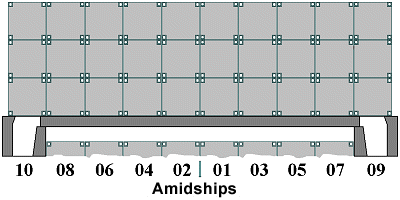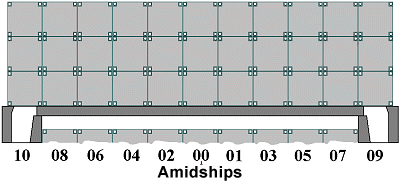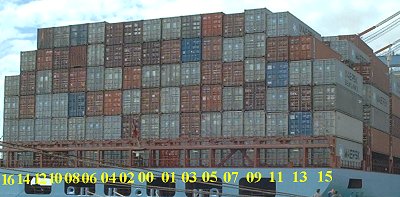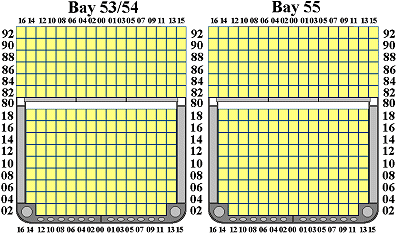The bay-row-tier system follows a system of numerical coordinates relating to length, width and height. The stowage space of the container on board the ship is unambiguously stated in numbers and is (almost always) recorded in the shipping documents. It is then also possible to establish at a later date where the container was carried during maritime transport.
 |
|
| Principle of bay-row-tier coordinates |
According to this principle, bays are the container blocks in the transverse direction, rows are the lengthwise rows and tiers are the vertical layers.
 |
|
| Thirty-eight 20' container bays on a ship |
Theoretically, the thirty-eight bays could be numbered continuously from 1 to 38. However, that would only be sensible if only 20' containers could actually be loaded.
 |
|
| Nineteen 40' container bays on a ship |
If the ship could only transport 40' containers, the nineteen bays could be numbered continuously from 1 to 19.
 |
|
| Bay numbering system |
Since, however, the ship can transport both 20' and 40' containers, the bay spaces for 20' containers are numbered throughout fore to aft with odd numbers, i.e. in this case 01, 03, 05 and so on up to 75. The bay spaces for 40' containers are numbered throughout with even numbers: 02, 04, 06 and so on up to 74.
The purple 20' container in the first bay has the bay number 01. The light-brown 20' container in the second bay has the bay number 03 and the light-blue 40' container, which occupies a space in the first and second bays, has the bay number 02. The magenta-colored container has the bay number 25, the dark-green number 27 and the light-green number 26.
To illustrate a cross-section through a bay, one needs to imagine that one is standing in front of or behind the ship.
 |
|
| In the case of bay plans, the respective bay is always viewed from behind. |
The rows of containers on a ship are numbered with even numbers from the center leftward and odd numbers from the center rightward.
 |
|
| Row numbering where there is an even number of rows |
Where there is an odd number of rows, the middle row is numbered 00.
 |
|
| Row numbering where there is an odd number of rows |
 |
|
| Numbering of the port rows on board ship |
On close inspection, the photograph shows left-hand row 16, which is designed to be filled with containers only on deck, and rows 14, 12, 10, 08, 06, which may be filled both on deck and in the holds. Rows 04, 02, 00, 01 and 03 are likewise designed to be occupied in the hold and on deck. However, the hatch covers are already on in this case.
 |
|
| Numbering of the starboard rows on board ship |
Rows 05, 07, 09, 11 and 13 are still empty in this bay. Row 15 is designed only for on deck occupation, and is still free in this bay.
 |
|
| Row numbers of the aft bay of a ship |
The container tiers are numbered with even numbers, starting from the bottom. The conventional way is start with 02 in the hold and then count up with 04, 06 etc. In the case of deck cargoes, it is conventional to start numbering with 80 or 82. There are sometimes slight differences between ships.
 |
|
| Numbering of horizontal container layers, or tiers |
On this ship, the containers standing directly on the main deck are numbered 80 and those standing on the hatches are number 82. The number is incremented by two for each higher layer.
These bay, row and tier numbers are noted in the bay plans.
 |
|
| Bay plan |
The loaded containers, with their alpha prefix, their container numbers, the port of destination or discharge and other important details are noted in the bay plans.
 |
|
| Color-labeled containers in a bay plan |
According to the bay-row-tier system, the colored containers were given the following stowage space numbers:
- a 20' container in the red-colored slot: 531212
- a 40' container in the blue-colored slot: 540788
- a 20' container in the green-colored slot: 551184